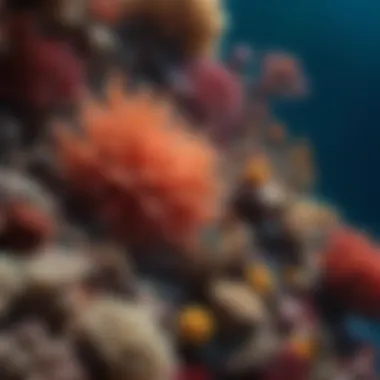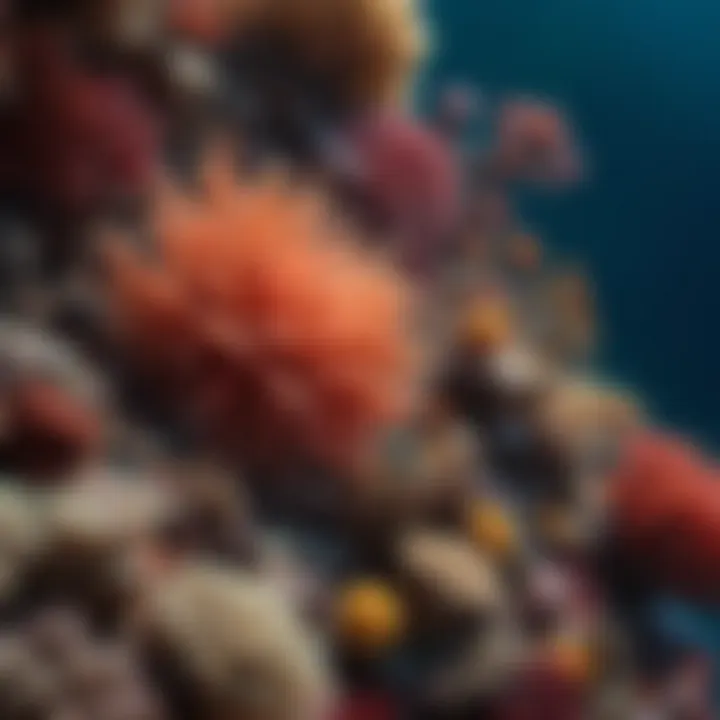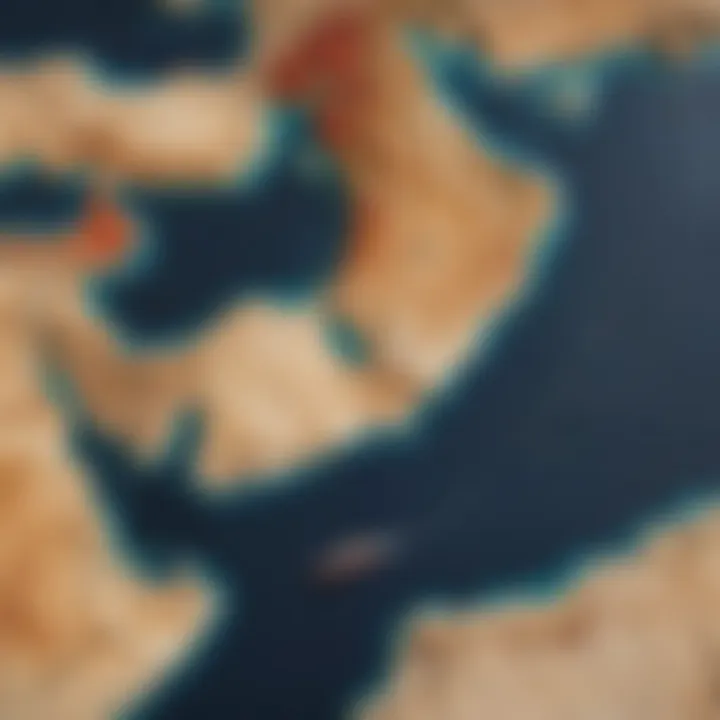Understanding the Red Sea: An In-depth Exploration


Research Overview
In examining the Red Sea, a multifaceted approach is essential. The integration of geographical data, ecological assessments, and historical context gives a richer understanding. Research focuses on various aspects of the sea, including its formation, marine life, and socio-economic impact.
Methodological Approaches
Research methodologies vary significantly depending on the focus area.
- Geographical Studies: These often utilize satellite imagery and geographical information systems (GIS) to analyze the surface and subsurface characteristics of the Red Sea. Such tools allow researchers to visualize changes over time, contributing to a comprehensive understanding of its physical layout.
- Ecological Research: Marine biologists often employ underwater surveys and ecological modeling to study biodiversity and environmental changes. This includes researching species interactions and the health of coral reefs, which are crucial to the sea's ecosystems.
- Historical Analysis: Historical research focuses on maritime trade routes and cultural exchanges that the Red Sea facilitated. Documented records and archeological finds are key in understanding the sea’s historical significance.
Significance and Implications
Understanding the Red Sea extends beyond academia. The implications are vast, bridging ecological study and socio-economic realities. The Red Sea is a vital route for international shipping, making it integral to global trade.
Researchers have noted that learning about its ecosystems can foster better conservation efforts, crucial in the face of environmental challenges. The Red Sea also plays a role in local economies, particularly through tourism and fishing. Thus, insights gained from research can guide policies that balance economic growth and environmental protection.
Current Trends in Science
Today’s research is significantly shaped by advancements in technology and interdisciplinary approaches. Scientists from various fields are coming together to tackle the complex issues surrounding the Red Sea.
Innovative Techniques and Tools
Modern techniques, including remote sensing and environmental DNA (eDNA) analysis, have transformed how researchers study marine environments. Remote sensing helps monitor water quality and temperature changes, while eDNA facilitates the detection of marine species without the need for direct observation. These methods provide crucial data that contribute to our understanding of biodiversity and ecosystem health.
Interdisciplinary Connections
The study of the Red Sea increasingly involves collaboration across disciplines. Marine biology, geography, history, and climate science intersect in many projects. This collaborative framework allows for comprehensive insights into the sea’s ecological dynamics and historical context, enabling more effective management strategies.
“The Red Sea is not only a physical boundary but also a crucible for cultural exchange and biodiversity.”
In summary, this layered approach to understanding the Red Sea reveals a wealth of knowledge. It underscores the need to view natural phenomena through multiple lenses, enriching our comprehension and informing future actions relevant to this unique maritime environment.
Prologue to the Red Sea
The Red Sea is a body of water that has long captured the attention of scientists, historians, and travelers alike. Understanding the Red Sea is important because it serves as a unique ecological system that supports a vast array of marine life and holds significant biological and geological importance. The intersection of Europe, Asia, and Africa at this body of water also allows for a rich historical narrative that spans centuries. This section lays the foundation for the subsequent exploration of its geography and history.
Geographical Location
The Red Sea is situated between northeastern Africa and the Arabian Peninsula. It is connected to the Mediterranean Sea via the Suez Canal in the north, and to the Gulf of Aden via the Bab el Mandeb strait in the south. The sea spans approximately 2,300 kilometers in length, varying in width from 24 kilometers at its narrowest point to around 355 kilometers at its widest. This geographical positioning not only makes it a crucial waterway for international shipping but also influences the climate and ecosystem in the region.
The coastline consists of several countries, including Egypt, Sudan, Saudi Arabia, and Yemen, creating diverse environments ranging from sandy beaches to rocky coves. Significant coral reefs thrive in its shallow waters, making the Red Sea a notable site for biodiversity, especially in marine life. Such geographical characteristics are critical for understanding the ecological framework that the next sections will delve into.
Historical Context
The history of the Red Sea is rich and diverse, contributing to its significance as a historical conduit for trade and cultural exchange. From ancient times, the Red Sea has facilitated trade routes between Africa, Asia, and Europe. It was used by Pharaohs of Egypt who sought connections with civilizations in the Arabian Peninsula. The sea served as a maritime route for traders, not only for spices and gold but also for ideas and cultures.
Moreover, throughout different eras, this body of water has witnessed explorations and conquests, notably the voyages of renowned figures such as Christopher Columbus. The historical relevance of the Red Sea cannot be understated as it has played a pivotal role in shaping the cultures across its shores.
With each of these historical layers, one finds an array of navigational advances that have enabled exploration and the establishment of maritime laws. The background of the Red Sea is also intertwined with the rise and fall of empires and trade networks, making it a focal point for understanding the interconnectedness of ancient societies.
Through this examination, one gains insight into both its past and how it shapes contemporary interactions in the region.
Geological Formation
The geological formation of the Red Sea is critical to understanding not only its current ecological status but also its historical development. This body of water is often cited as one of the youngest oceans on Earth. Its formation is tied directly to tectonic activity that affects not just the sea itself but neighboring regions. The geology of the Red Sea shapes its marine life, affects its biodiversity, and influences human activities surrounding it.
Tectonic Activity and Plate Movements
The Red Sea is primarily shaped by the interaction of several tectonic plates. The divergent movements of the African and Arabian plates create a unique geological setting. As these plates pull apart, they allow magma to rise, forming new oceanic crust. This process is crucial as it allows for the continued evolution of the sea. The rifting is also responsible for various geological features. For instance, the presence of deep rift valleys is a direct result of ongoing tectonic pressures.
This tectonic activity not only contributes to the physical landscape but also impacts seismic events in the area. Earthquakes along the boundaries can trigger landslides, impacting marine habitats significantly. Furthermore, tectonic activity affects sedimentation processes which are essential for coral reef health. Coral reefs thrive in stable environments, and changes in the geological formation can alter these conditions.


"The tectonic evolution of the Red Sea gives insights into plate tectonics, making it a natural laboratory for geoscientists."
Source: Wikipedia
Formation of Rift Valleys
Rift valleys are vital geographical formations within the Red Sea system. These valleys are formed as the tectonic plates separate, creating an elongated depression. This feature is significant for several reasons. First, it affects the hydrodynamics of the sea. The depth of rift valleys can influence water circulation patterns, which impacts temperature and nutrient distribution.
Second, rift valleys contribute to the rich biodiversity characteristic of the Red Sea. The unique geological conditions provide habitats for a variety of marine life. They play a central role in the ecological economy of the area, supporting coral reefs and numerous fish species. Moreover, the depth changes within these valleys create variations in light and temperature, fostering diverse ecosystems.
To summarize, the geological formation of the Red Sea, characterized by its tectonic activity and the formation of rift valleys, creates an intricate interplay between geological processes and ecological health. This foundation is essential for understanding the broader implications of this marine ecosystem's socio-economic and environmental significance.
Marine Biodiversity
Marine biodiversity in the Red Sea is as complex as it is vital. This body of water is home to a variety of marine life, which collectively contributes to its ecological balance. The significance of marine biodiversity cannot be understated; it supports the health of the ecosystem, provides resources for local communities, and offers insights into environmental changes. Understanding the unique features of marine biodiversity in the Red Sea is essential for conservation efforts and sustainable practices.
Coral Reefs
Coral reefs in the Red Sea are among the most unique and diverse ecosystems found on the planet. They span across a considerable area and provide habitat for thousands of species. The reefs serve as a crucial feeding ground and breeding zones for many marine organisms.
The primary species, such as Acropora, Porites, and Favia, populate these reefs and are integral in maintaining the health of the marine environment. Additionally, coral reefs act as natural barriers against coastal erosion.
Maintaining the health of these reefs is critical, as they are sensitive to changes in water temperature and quality. Protecting coral reefs from threats like pollution and climate change is fundamental for preserving the biodiversity they support.
Fish Species
The diversity of fish species in the Red Sea is impressive. Over 1,200 species call this body of water home, making it a hub for both research and recreation. Notable residents include Clownfish, Napoleon Wrasse, and various species of Snapper.
These fish not only contribute to the food web but also have economic importance. Many local communities rely on fishing as a source of livelihood. Overfishing, however, poses a considerable threat to fish populations, demanding urgent interventions and responsible fishing practices.
Efforts to protect fish populations can lead to sustainable fisheries, benefiting both ecosystem health and local economies. Monitoring fish species helps in evaluating the impact of human activities on marine life.
Endangered Species
The Red Sea is home to several endangered species, each facing unique challenges. For example, the Hawksbill Turtle is critically endangered, primarily due to habitat loss and illegal poaching. Similarly, the Dugong, a marine mammal, is threatened by habitat degradation and hunting.
Preserving these endangered species is not merely an act of conservation; it is a crucial step toward maintaining the ecological integrity of the Red Sea. Protecting their habitats and addressing the root causes of their decline is essential. Collaborative efforts between governments, NGOs, and local communities are necessary to ensure these species do not further decline.
"Biodiversity loss is not just an environmental issue; it also has social and economic implications, particularly for communities reliant on the marine ecosystem."
Environmental Significance
The Red Sea plays a crucial role in global environmental dynamics. Its unique geographical position fosters a distinctive marine ecosystem that contributes significantly to ecological balance. Understanding this significance provides insight into not only the Red Sea itself but also the broader climate systems in which it functions. The environmental significance of the Red Sea can be categorized into two main aspects: its role in climate regulation and its status as a biodiversity hotspot.
Role in Climate Regulation
The Red Sea contributes to climate regulation in multiple ways. Its waters act as a major heat reservoir, influencing regional and global climate patterns. The sea's high salinity and temperature vary seasonally, creating complex interactions with atmospheric conditions.
- The evaporation from the Red Sea contributes to the humidity in surrounding regions.
- This moisture is vital for regional weather patterns, including precipitation in nearby areas.
- The currents of the Red Sea help distribute heat across oceanic systems, impacting climate not just locally but also further afield.
"The Red Sea’s unique hydrographic conditions allow it to play a critical role in both local and global climate systems."
Additionally, the Red Sea supports significant carbon sequestration. Through its marine flora, such as seagrasses and corals, it captures carbon dioxide, thereby helping mitigate climate change. This aspect is increasingly recognized as vital in global strategies to combat climate change.
Biodiversity Hotspot
The Red Sea is classified as a biodiversity hotspot due to its unique array of marine life and high levels of endemism. It is home to a vast variety of species, some of which are not found anywhere else in the world.
Key features of this biodiversity hotspot include:
- Coral reefs: The Red Sea’s coral reefs are among the most diverse and resilient. They harbor numerous fish species, invertebrates, and crustaceans, offering essential services such as coastal protection and tourism resources.
- Fish diversity: Approximately 1,200 species of fish inhabit its waters, including the famous clownfish and parrotfish. Many of these species are commercially valuable and play an essential role in local fisheries.
- Endangered species: The region is also home to several endangered species, like the hawksbill turtle and the dugong, making the conservation of this area critical for their survival.
Recognizing the Red Sea as a biodiversity hotspot underscores the need for conservation efforts. Protecting this region is vital not only for its marine inhabitants but also for human societies that depend on these ecosystems for their livelihoods and well-being.


Socio-Economic Importance
The Red Sea holds a significant position in the socio-economic landscape of the region. Its unique geographical location facilitates trade and commerce while providing livelihoods to millions. Understanding the socio-economic importance is essential, as it encompasses various facets like fishing, tourism, and shipping. These elements not only contribute to local economies but influence global trade dynamics.
Fishing Industry
Fishing is one of the most traditional economic activities in the Red Sea. The diverse marine ecosystems support an array of fish species, making it a prime location for both commercial and artisanal fishing. Local communities depend on the fishing industry for sustenance and income.
- Key Fish Species: Popular species include grouper, snapper, and tuna.
- Economic Impact: In some coastal areas, fish catch represents a substantial portion of the local economy, boosting jobs in fishing, processing, and distribution.
- Sustainable Practices: However, overfishing is a growing concern. Sustainable fishing practices are vital to maintaining fish stocks and the livelihoods of local fishermen.
Tourism Potential
The Red Sea is known for its stunning coral reefs and crystal-clear waters, making it a popular destination for tourists. Diving, snorkeling, and water sports attract millions of visitors each year.
- Economic Contributions: Tourism generates significant revenue for countries bordering the Red Sea. This includes direct spending by tourists as well as indirect benefits such as job creation in hospitality sectors.
- Attractions: Popular sites, like Sharm El Sheikh and Hurghada, offer unique experiences that appeal to a wide range of travelers.
- Challenges: Nevertheless, mass tourism can strain environmental resources, and it's essential to find a balance between economic gain and preservation of natural beauty.
Shipping Routes
The Red Sea serves as a crucial conduit for international shipping. It connects Europe and Asia through the Suez Canal, making it one of the most vital shipping lanes in the world.
- Major Trade Route: Approximately 10% of global trade passes through this region, underscoring its strategic importance.
- Economic Impact: The shipping industry not only facilitates trade but also supports ports and related industries, creating numerous job opportunities.
- Security Concerns: However, geopolitical tensions can affect shipping routes and safety, making maritime security a recurring issue that needs addressing.
Understanding the socio-economic importance of the Red Sea is not just about immediate benefits; it entails considering how these aspects impact local communities and global economies.
Environmental Challenges
The Red Sea is not just a body of water, but a complex environment under threat from various challenges. These challenges are critical to understanding the overall health of this marine ecosystem. Recognizing these issues is essential to mitigate their effects and protect not only the Red Sea but also the wider global marine environment. Each element, from pollution to climate change, holds significant importance and requires attention.
Pollution Issues
Pollution in the Red Sea predominantly arises from human activities. Urban runoff, industrial discharges, and oil spills have introduced harmful substances into its waters. The tourism boom has further strained the region; littering and improper waste management frequently occur. This pollution affects all forms of marine life, leading to the degradation of coral reefs, which are vital for biodiversity and the overall health of the marine ecosystem.
The impact of pollution can be seen in the following ways:
- Chemical pollutants: Heavy metals and other chemicals lower water quality and threaten aquatic life.
- Microplastics: These tiny particles have been found in various marine organisms, raising concerns about the food chain.
- Nutrient loading: Excess nutrients lead to algal blooms, which deplete oxygen levels in water and can create dead zones.
"The health of the Red Sea is directly tied to human activity, making pollution a persistent and pressing concern."
Climate Change Impacts
The Red Sea is acutely vulnerable to climate change. Rising temperatures affect water temperatures, leading to coral bleaching. This phenomenon occurs when the symbiotic relationship between corals and algae breaks down, causing corals to lose their color and essential energy sources. Increased ocean acidification, another consequence of climate change, alters the marine chemistry, making it challenging for marine organisms to develop and maintain their calcium carbonate structures.
The impacts of climate change on the Red Sea include:
- Altered marine biodiversity: Species migration can upset the existing ecological balance.
- Increased frequency of extreme weather: Hurricanes and storms are becoming more intense, which can further damage marine habitats.
- Disruption of local communities: Reliance on fishing and tourism can be compromised.
Overfishing Concerns
Overfishing remains a serious threat to the Red Sea's marine fauna. Unsustainable fishing practices have led to significant declines in fish populations. Species that are crucial for maintaining the ecosystem balance, such as parrotfish and lionfish, are becoming scarcer. The pressure from commercial fishing often leads to destructive practices such as bottom trawling, which damages coral reefs and other habitats.
Key aspects of overfishing include:
- Bycatch: Non-target species caught in fishing nets often face accidental death, leading to declining populations.
- Reduced fish stocks: This affects not only the marine ecosystem but also local economies reliant on fishing.
- Increased regulation: Governments are beginning to recognize the need for sustainable practices, but enforcement remains a challenge.
So, environmental challenges surrounding the Red Sea are multifaceted. Pollution, climate change, and overfishing interplay in ways that threaten this unique ecosystem. Addressing these issues requires global cooperation and dedicated efforts from local communities, government bodies, and international organizations.
Conservation Efforts
Conservation efforts in the Red Sea are critical for its ecological stability and the preservation of its rich biodiversity. Various factors threaten the delicate balance of this unique marine environment. As such, coordinated actions towards conservation have become imperative. These efforts not only aim to protect marine life but also to sustain the livelihoods of communities that rely on these ecosystems.
Protected Areas


Protected areas play a vital role in conserving the natural habitats within the Red Sea. Numerous marine protected areas (MPAs) have been established to safeguard various species and habitats. Examples of such areas include the Ras Mohammed National Park in Egypt and the Saudi Arabian protected areas like the Farasan Islands.
The importance of these areas cannot be overstated. They serve as sanctuaries for numerous fish species and corals, allowing for recovery from overfishing and habitat destruction. Establishing regulations on fishing practices and restricting damaging activities, such as coastal development, significantly benefits the ecosystems in these zones.
Some key features of protected areas include:
- Biodiversity hotspots: These areas often contain a high variety of species, some of which are endemic and cannot be found elsewhere.
- Research opportunities: Protected regions provide sites for scientific studies, fostering knowledge about marine ecosystems and how they respond to human impact.
- Tourism and education: These areas can attract eco-tourism, facilitating understanding of marine conservation's importance among visitors.
Community Involvement
Engaging local communities in conservation efforts is fundamental. When communities are involved, they are more likely to see the benefits of protecting their environment. Volunteer programs often draw in residents, promoting local stewardship of marine resources.
One notable example of community involvement is the efforts by local fishermen in several areas of the Red Sea who have adopted sustainable fishing practices. These practices help in managing fish populations and ensuring long-term viability for both the fisheries and marine habitats.
Some aspects of community involvement include:
- Education and awareness: Programs that inform locals about the impacts of overfishing and pollution can foster a sense of responsibility towards the environment.
- Resource management: Involving communities in the management of local fishing quotas can lead to more balanced and sustainable use of marine resources.
- Collaboration with NGOs: Partnerships with non-governmental organizations encourage knowledge-sharing and resource allocation to support conservation initiatives effectively.
"Involving local communities in conservation is not merely a strategy; it is an ethical necessity for sustainable development in the Red Sea."
Active participation and support for conservation will enhance the resilience of the Red Sea ecosystem. Preserving this unique marine environment ensures it continues to thrive while providing ecological and socio-economic benefits for generations to come.
Future Prospects
The future prospects of the Red Sea hold significant importance for various stakeholders, including researchers, policymakers, and communities reliant on its resources. The evolving context surrounding the Red Sea highlights the need for sustained attention towards its ecological health and socio-economic development. As the geopolitical landscape changes, understanding the possibilities for future research and sustainable practices becomes crucial.
Research Opportunities
The Red Sea presents numerous research opportunities. Scientists can enhance understanding of marine ecosystems, particularly in areas such as:
- Coral Resilience: Exploring how coral reefs adapt to climate stressors can provide insights into conservation strategies.
- Biodiversity Assessment: Research focused on the myriad species inhabiting the waters can improve knowledge of their roles within the ecosystem.
- Pollution Impact Studies: Investigating effects of different pollutants can guide mitigation efforts that are crucial for marine health.
These studies are vital for establishing a robust scientific foundation to inform conservation policies. Collaborations with regional institutions can bolster research capabilities and increase the relevance of findings.
Sustainable Development
Sustainable development in the Red Sea region requires careful balancing. Economic activities must align with environmental safeguards to ensure longevity. Key considerations include:
- Ecotourism: Promoting environmentally-friendly tourism can draw visitors while preserving natural habitats.
- Sustainable Fisheries: Implementing practices that avoid overfishing helps maintain fish populations and secures the livelihoods of local fishermen.
- Renewable Energy Initiatives: Exploring solar and wind energy options can provide alternative solutions that reduce reliance on fossil fuels.
Strong policy frameworks will be essential in fostering these sustainable practices. The involvement of local communities is also pivotal, as they can offer valuable knowledge and insights into sustainable resource management. It is important to recognize that the Red Sea is not just a body of water; it is a system that supports life and livelihoods. Therefore, ensuring its health and productivity is not only an ecological necessity but also a social and economic imperative.
"The Red Sea is a vital resource that requires careful stewardship to balance growth and conservation."
In summary, the future prospects of the Red Sea are built on a foundation of research and sustainable development practices. These aspects will guide efforts in maintaining ecological integrity while also supporting socio-economic growth.
Ending
The conclusion of this article offers a critical reflection on the various aspects regarding the Red Sea. It encapsulates the essential findings and highlights the relevance of understanding this unique body of water. The Red Sea stands as a testament to the intricate interplay between nature, human activity, and the environment. Its biodiversity presents both a treasure and a challenge, demanding vigilant conservation efforts. By synthesizing the knowledge gathered from historical, ecological, and socio-economic perspectives, we realize the profound implications of how we interact with this ecosystem.
Summary of Findings
The Red Sea is characterized by its distinct geographical location, unique geological formation, and vibrant marine life. Significant findings include:
- Geographical Importance: The Red Sea connects major countries and serves as an essential trade route for shipping and tourism.
- Biodiversity: It houses extensive coral reefs and various species of fish, some of which are endangered, underpinning its ecological importance.
- Socio-Economic Role: The fishing industry and tourism contribute significantly to regional economies, highlighting the need for sustainability.
- Environmental Concerns: This body of water faces pollution, climate change impacts, and overfishing, hinting at urgent action for preservation.
Call to Action
The need for comprehensive awareness and appropriate policy changes is imperative. Engaging with local communities and stakeholders can foster effective conservation strategies.
Importance of Awareness
Awareness of the Red Sea's ecological and socio-economic significance is vital. Educating various stakeholders enhances a collective understanding of environmental challenges. An informed populace can advocate for conservation efforts that align with local and global initiatives. The key characteristic of awareness lies in its ability to mobilize communities towards a common goal, making it a beneficial choice for this discussion. Unique features of awareness initiatives range from educational programs to social media campaigns that highlight environmental concerns, which can lead to better funding and support for conservation projects.
Need for Policy Changes
Policies governing the Red Sea must evolve to address current environmental challenges. Stronger regulations can combat pollution and overfishing, fostering sustainable practices among industries. Effective policy changes are rooted in collaboration between governments, businesses, and communities, making it a key aspect of this narrative. The unique feature of these policies is their potential to impact a broad range of stakeholders, ensuring protection while promoting economic growth. However, the challenges regarding the implementation and adherence of these policies remain. Recognizing these complexities is crucial for any successful conservation effort.



